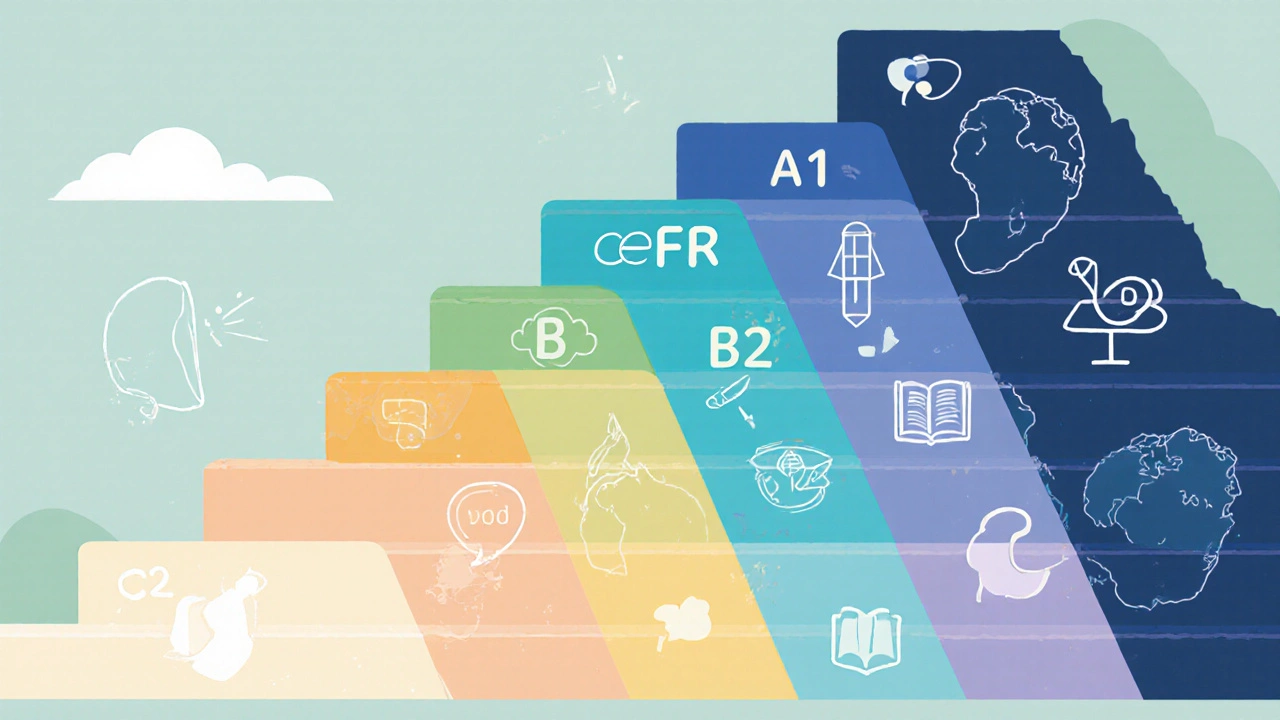
CEFR English Level Explorer
Click on any level below to learn more about its characteristics and real-world applications.
Select a CEFR level above to see its description and real-world examples.
When you hear terms like A1 or C2, you’re probably wondering what they actually mean for your English learning journey. Those letters are part of the CEFR (Common European Framework of Reference for Languages), a globally accepted system that maps language ability on a six‑tier scale. Knowing where you sit on the CEFR levels helps you pick the right course, set realistic goals, and compare your progress with learners worldwide.
Why the CEFR Matters
The CEFR was created by the Council of Europe in the early 2000s to provide a transparent, reliable way of describing language competence. It’s not tied to any single exam; instead, it translates the skills measured by IELTS, TOEFL, Cambridge tests, and many national exams into a common language. Schools, employers, and immigration authorities rely on it because it removes ambiguity: a B2 speaker in Spain has roughly the same capabilities as a B2 speaker in Japan.
Breaking Down the Six Levels
Each CEFR level groups four core skills - listening, speaking, reading, and writing - into a set of can‑do statements. Below, the descriptors are paired with everyday examples so you can instantly see whether they match your experience.
- A1 - "Beginner"
- Can introduce yourself and ask simple questions about personal details.
- Understands familiar everyday expressions (e.g., "Where is the bus stop?").
- Can fill out forms with basic personal information.
- A2 - "Elementary"
- Can describe your family, work, and immediate surroundings.
- Handles short social exchanges and can manage simple transactions (buying a ticket, ordering food).
- Understands short, clear messages in public announcements.
- B1 - "Intermediate"
- Can deal with most situations while traveling abroad.
- Writes simple connected text about familiar topics (e.g., a personal letter).
- Expresses opinions on everyday matters and can justify a point of view.
- B2 - "Upper‑Intermediate"
- Understands the main ideas of complex texts on both concrete and abstract topics.
- Participates actively in discussions, offering clear arguments and counter‑arguments.
- Writes detailed reports, essays, or project proposals without major language breakdowns.
- C1 - "Advanced"
- Understands nuanced language, idiomatic expressions, and implied meaning.
- Can produce well‑structured, coherent texts on complex subjects.
- Handles professional or academic communication with confidence.
- C2 - "Proficiency"
- Understands virtually everything heard or read with ease.
- Summarizes information from diverse sources, reconstructing arguments logically.
- Expresses ideas precisely, even in highly abstract or technical contexts.

How the Levels Translate to Popular Exams
Because many learners chase a certificate, it helps to see where the CEFR aligns with scores on well‑known tests. The table below gives a quick look at IELTS band equivalents, typical Cambridge exam names, and the approximate TOEFL iBT score range.
| CEFR Level | IELTS Band | Cambridge Exam | TOEFL iBT Score | Typical Use Cases |
|---|---|---|---|---|
| A1 | 1.0‑2.5 | Key English Test (KET) | 0‑30 | Basic survival English, tourism |
| A2 | 2.5‑4.0 | Pre‑intermediate (PET) | 31‑45 | Simple work tasks, community interaction |
| B1 | 4.0‑5.0 | First (FCE) | 46‑78 | Mid‑level jobs, study abroad (non‑academic) |
| B2 | 5.5‑6.5 | First for Academic Purposes (FAF) | 79‑94 | University entry, professional roles requiring communication |
| C1 | 7.0‑8.0 | Advanced (CAE) | 95‑110 | Advanced academic work, senior management |
| C2 | 8.5‑9.0 | Proficiency (CPE) | 111‑120 | Research, high‑level policy, translation |
How to Assess Your Current Level
Self‑evaluation works, but a formal test gives you a clear, recognized benchmark. Here’s a quick roadmap:
- Take a free online placement quiz that asks for a mix of grammar, vocabulary, and short‑answer questions. Many language schools host these on their sites.
- If the quiz points to a B1‑B2 range, book a Cambridge sample paper or an IELTS practice test. Aim for a score that lands you solidly inside the target band.
- Consider a professional assessment such as the TOEFL iBT or the Duolingo English Test if you need a quick, cost‑effective certificate for university admission.
- After you receive your result, compare the official description (the can‑do statements above) with your day‑to‑day language use. If you can comfortably handle most B2 tasks but struggle with C1 nuances, you’re ready to start a higher‑level course.
Choosing the Right Course for Your Target Level
Not all English courses are created equal. Align the curriculum with the CEFR descriptors to avoid wasted time.
- A1‑A2 courses: Focus on basic vocabulary, pronunciation drills, and survival dialogues. Look for titles that mention “Beginner” or “Foundation”.
- B1‑B2 programs: Expect a mix of grammar refinement, extensive reading, and writing practice (emails, reports). Courses that advertise “Upper‑Intermediate” usually target B2.
- C1‑C2 tracks: These are intensive, often with academic writing, debate clubs, and advanced listening (lectures, podcasts). Choose programs labeled “Advanced” or “Proficiency”.
Many institutes also offer “exam‑focused” pathways that map directly to Cambridge, IELTS, or TOEFL formats, which can speed up preparation for a specific certification.

Common Pitfalls and How to Avoid Them
It’s easy to misjudge your level, especially when you’re motivated to move up quickly. Here are three mistakes learners make and a quick fix for each.
- Over‑relying on classroom comfort. If you feel at ease during lessons, you might still be stuck at a lower CEFR band. Pair classwork with authentic materials-news articles, podcasts, or real‑world conversations-to test your limits.
- Skipping regular self‑assessment. Language fades without feedback. Schedule a short mock test every 4‑6 weeks and track progress against the can‑do list.
- Focusing only on one skill. Many learners excel in reading but lag in speaking. Treat each skill as a separate mini‑goal: a 10‑minute daily speaking journal, a weekly essay, a podcast‑listening sprint, etc.
What's Next After Reaching C2?
Even a native‑level speaker can keep sharpening skills. Consider these pathways:
- Specialized terminology courses (legal English, medical English, business jargon).
- Academic research writing workshops to refine citation style and argument structure.
- Teaching certification (TESOL, CELTA) if you want to turn your proficiency into a career.
At this stage, the CEFR becomes a reference point rather than a goal-you’re already fluent, so the focus shifts to precision and domain‑specific expertise.
Frequently Asked Questions
What does A1 actually mean in everyday life?
An A1 speaker can introduce themselves, ask simple questions, and understand basic signs or menus. Think of a tourist who can ask for directions but needs help with complex instructions.
Can I jump from B1 to C1 without a B2 step?
It’s rare. B2 acts as the bridge where you solidify complex grammar and start handling abstract ideas. Skipping it often leaves gaps that become obvious in academic or professional settings.
How long does it usually take to move between levels?
Progress varies by intensity. A full‑time immersion program (20‑30 hours/week) might cover a level in 3‑4 months, whereas a part‑time class (5‑8 hours/week) often needs 6‑12 months per level.
Do online courses follow the CEFR?
Reputable platforms label their tracks with CEFR letters and provide placement tests. Always verify that the syllabus mentions the four skills and the specific can‑do statements for the target level.
Is a higher CEFR level always better for job applications?
Employers care about functional ability. For many roles, B2 is sufficient; senior or specialist positions may require C1 or higher. Align your target level with the job description’s language expectations.
